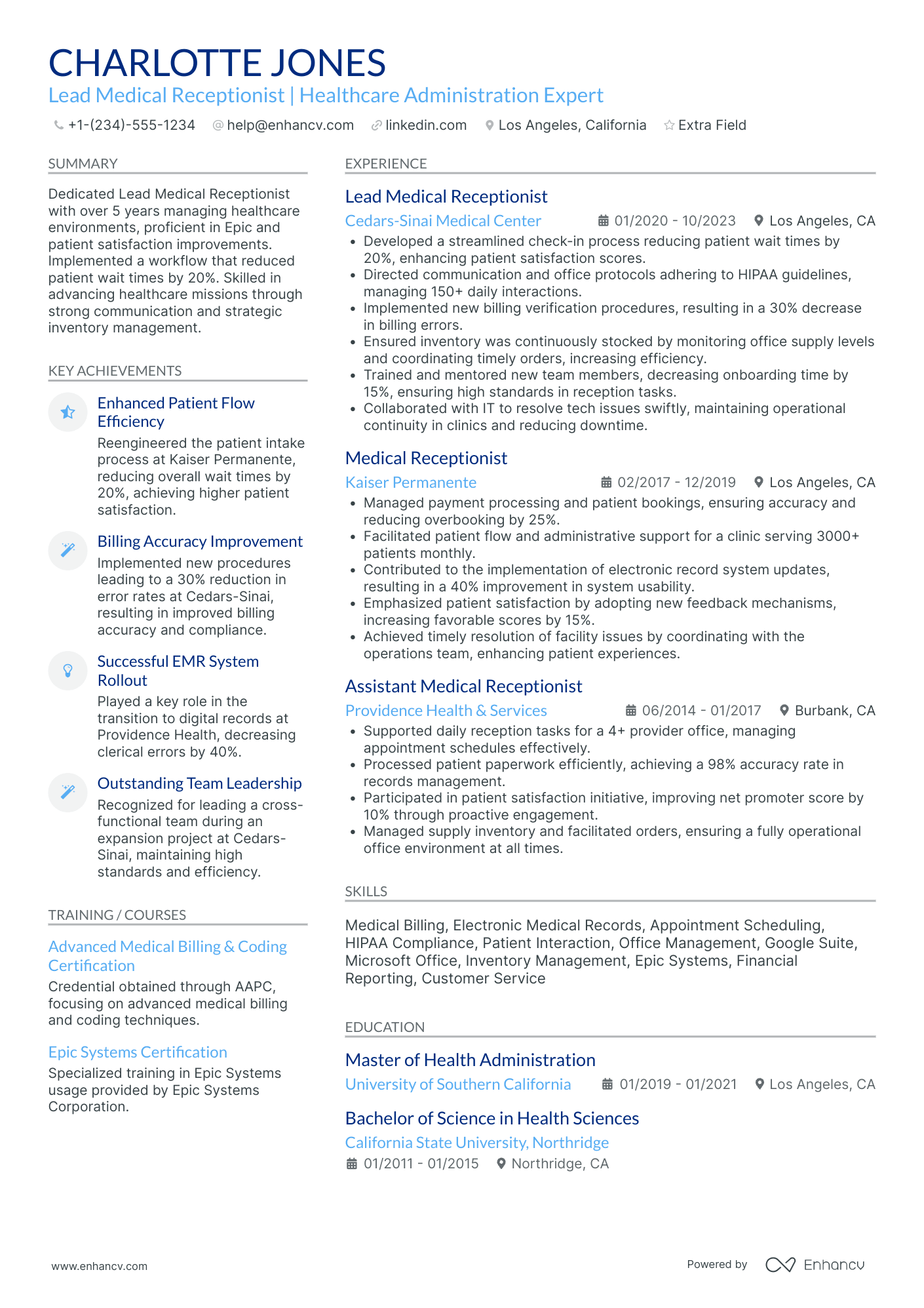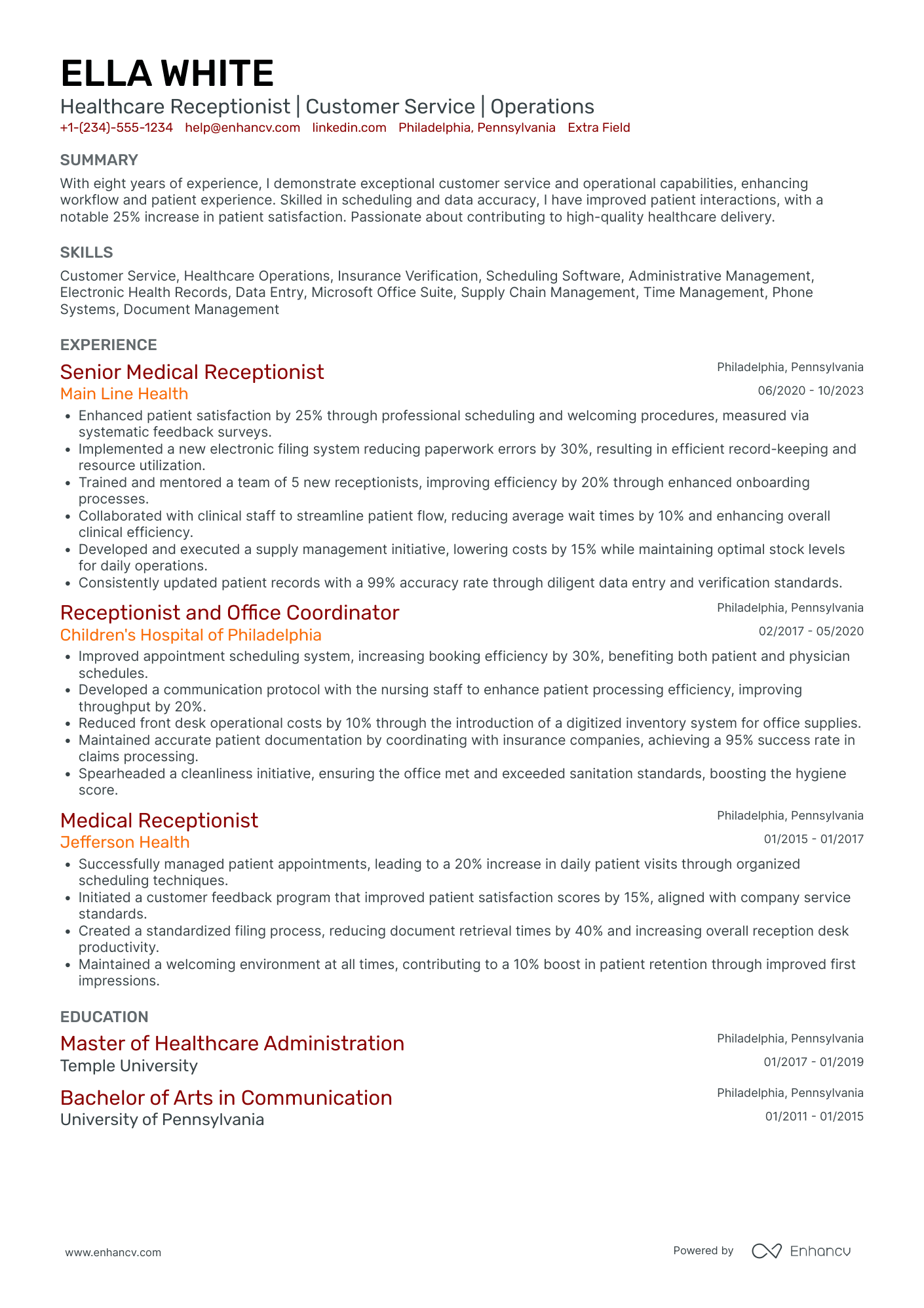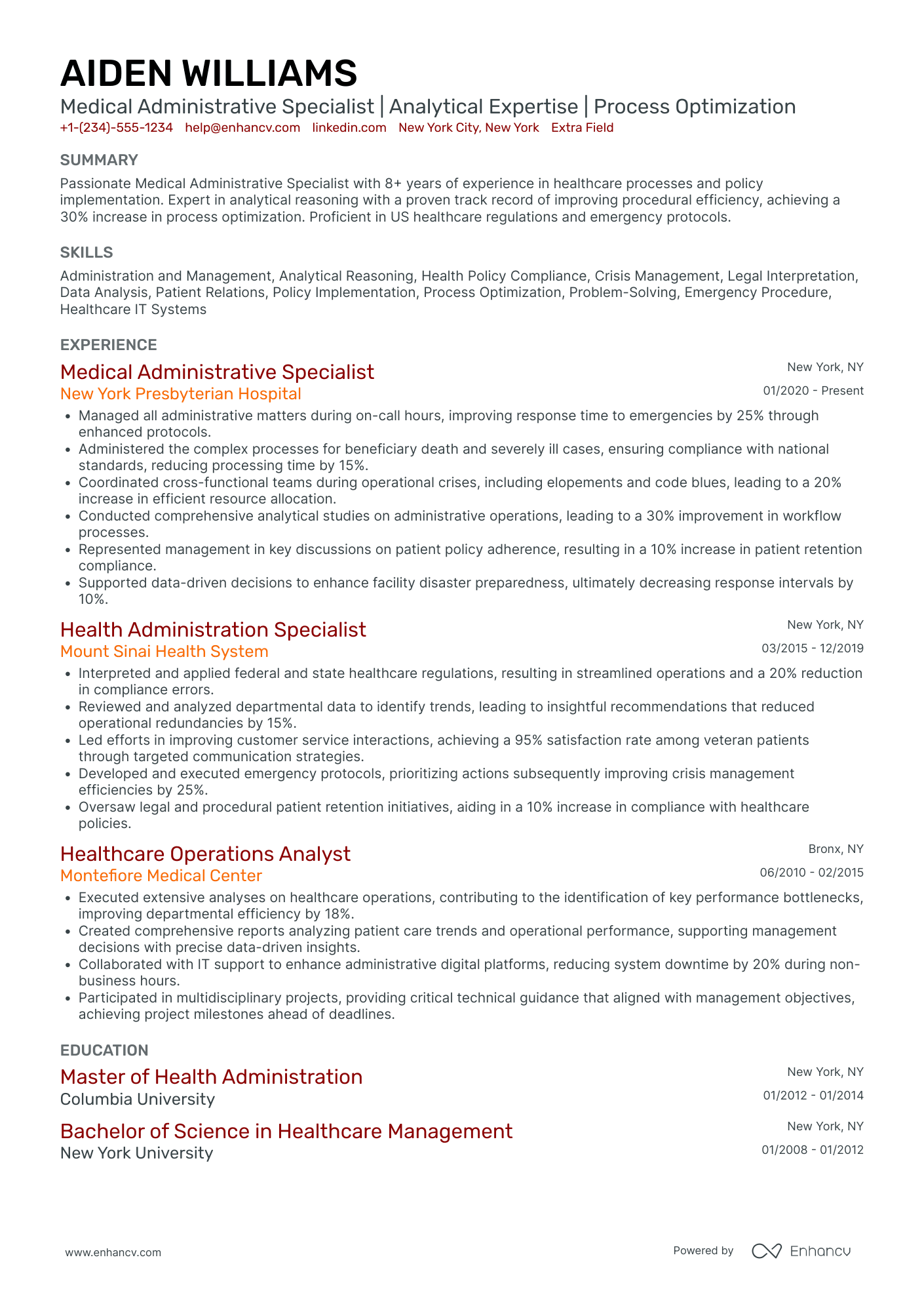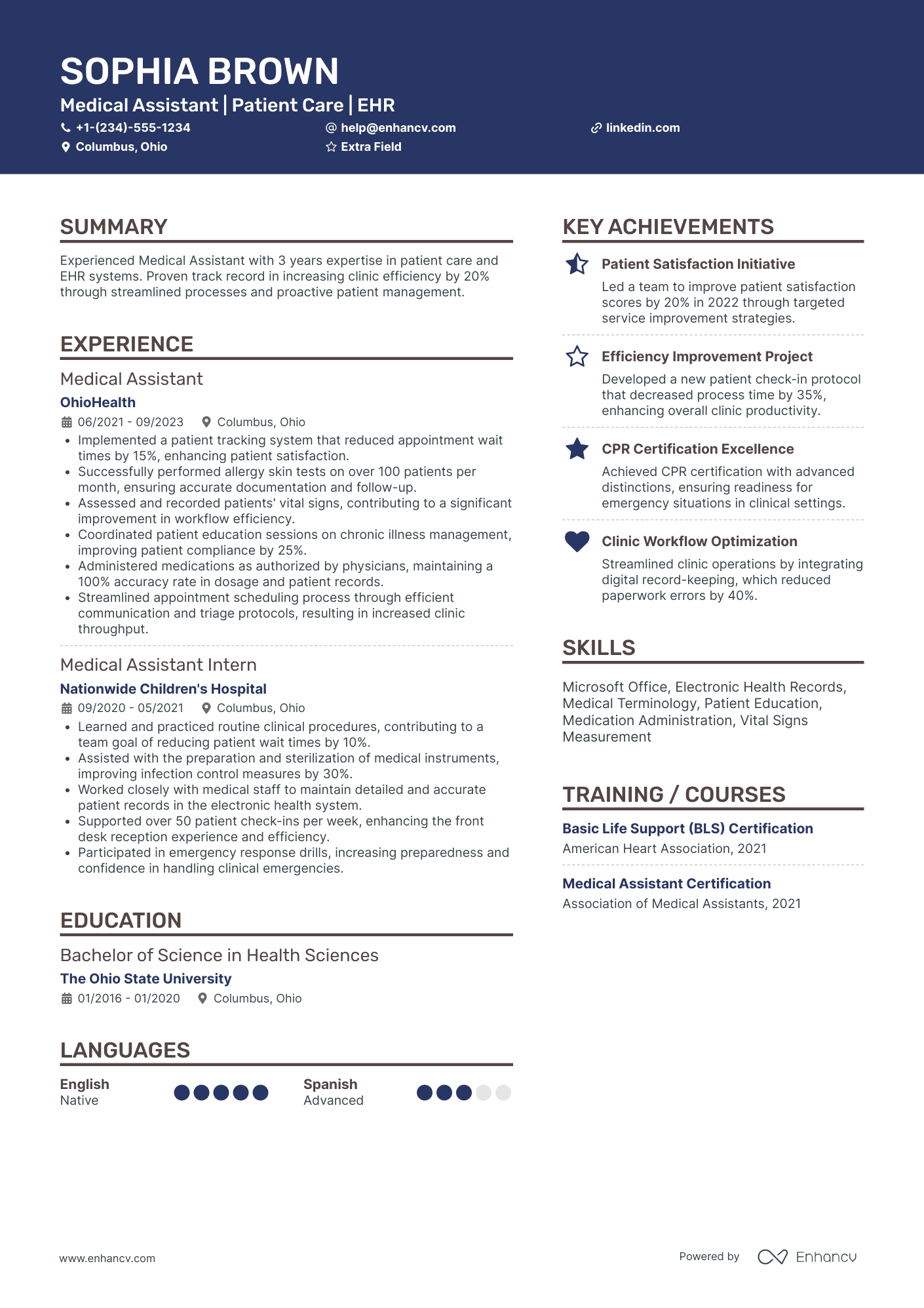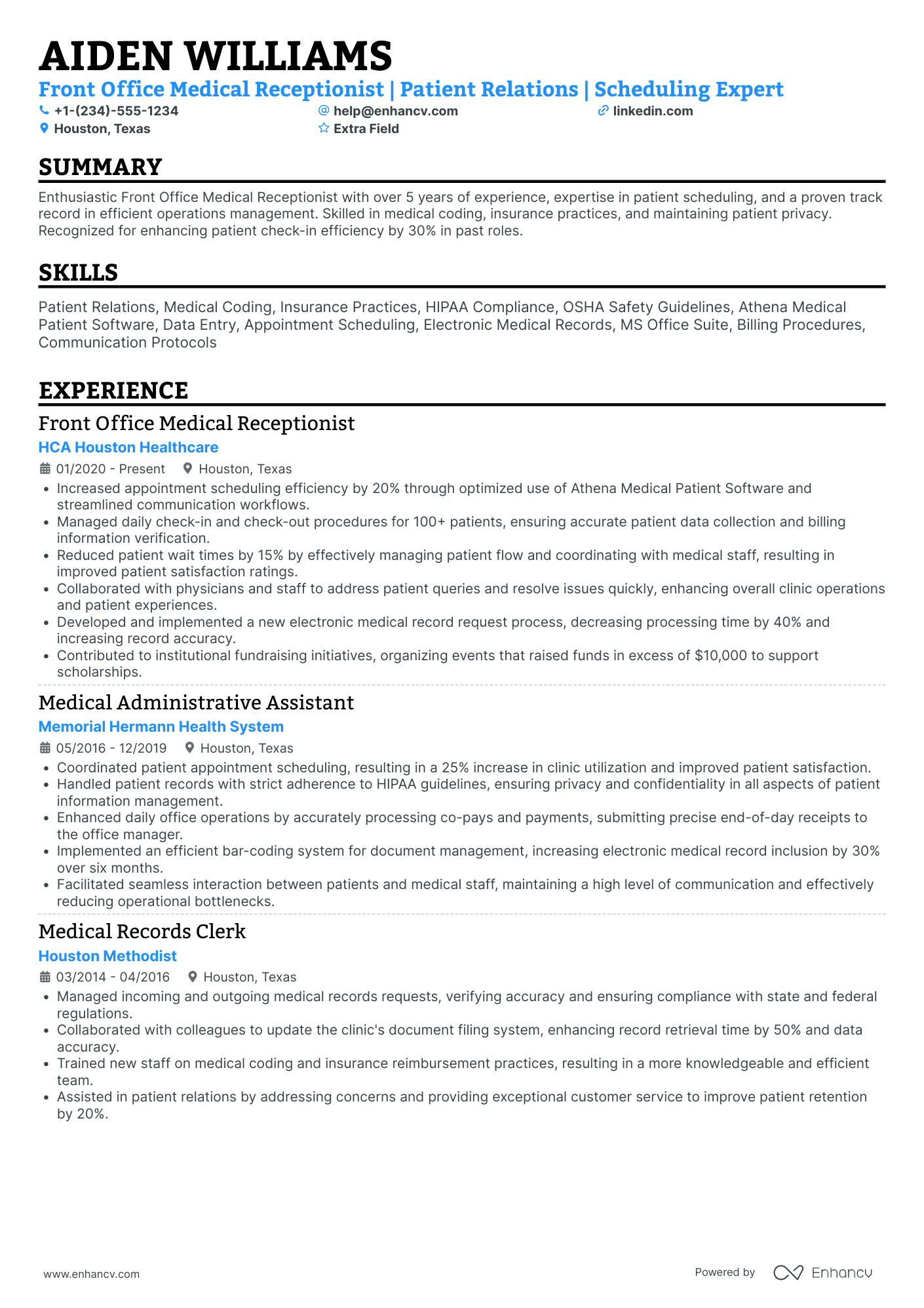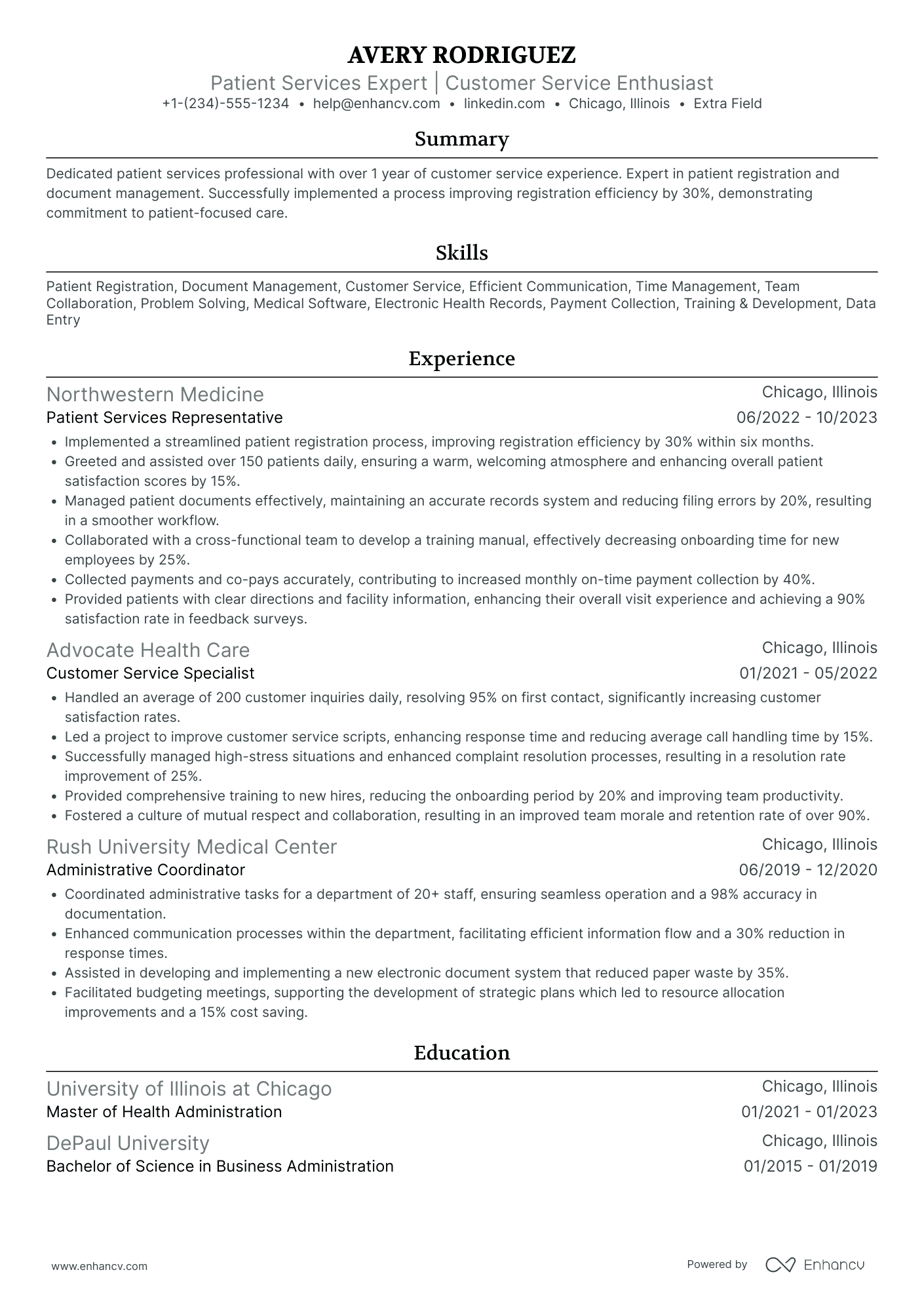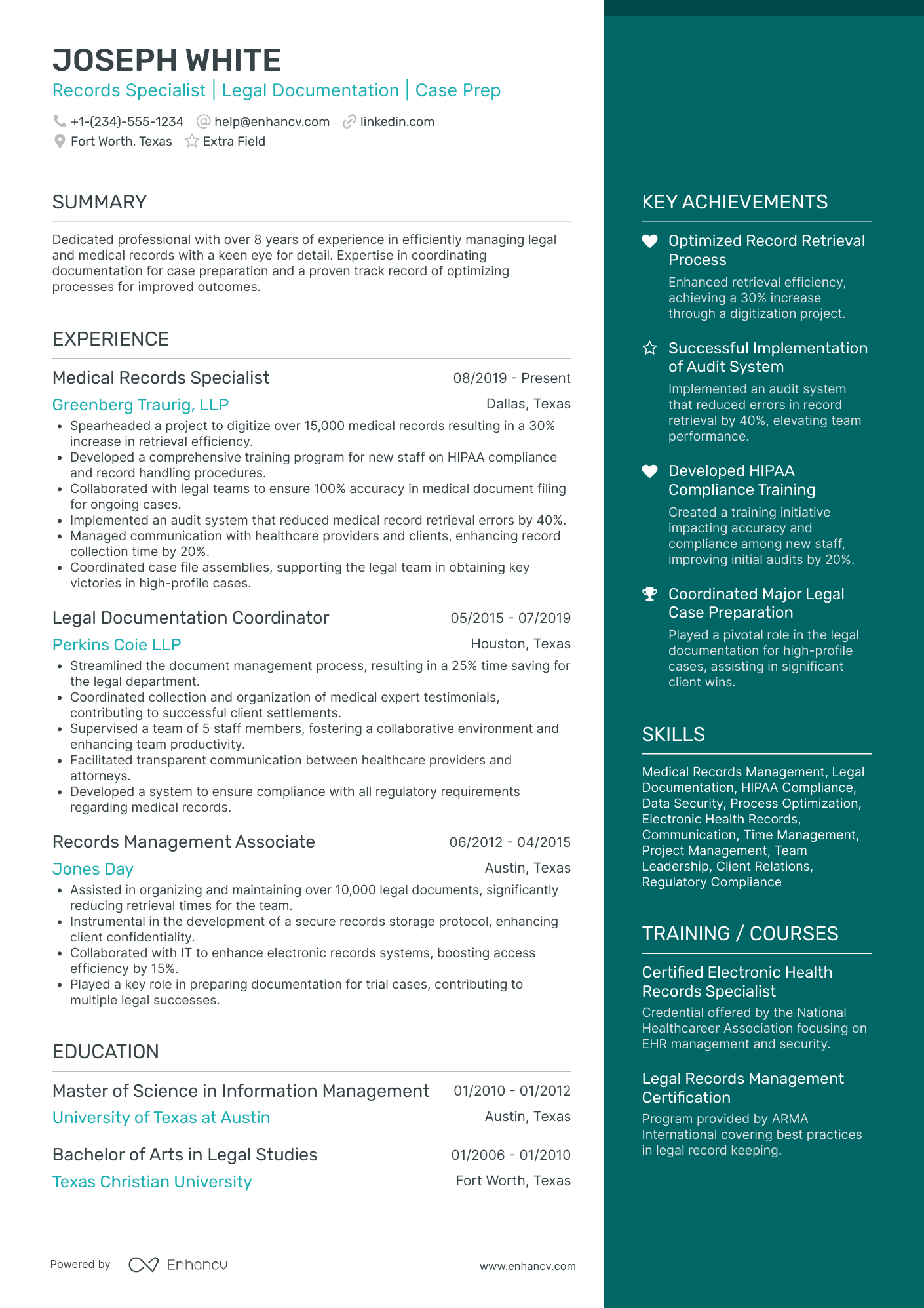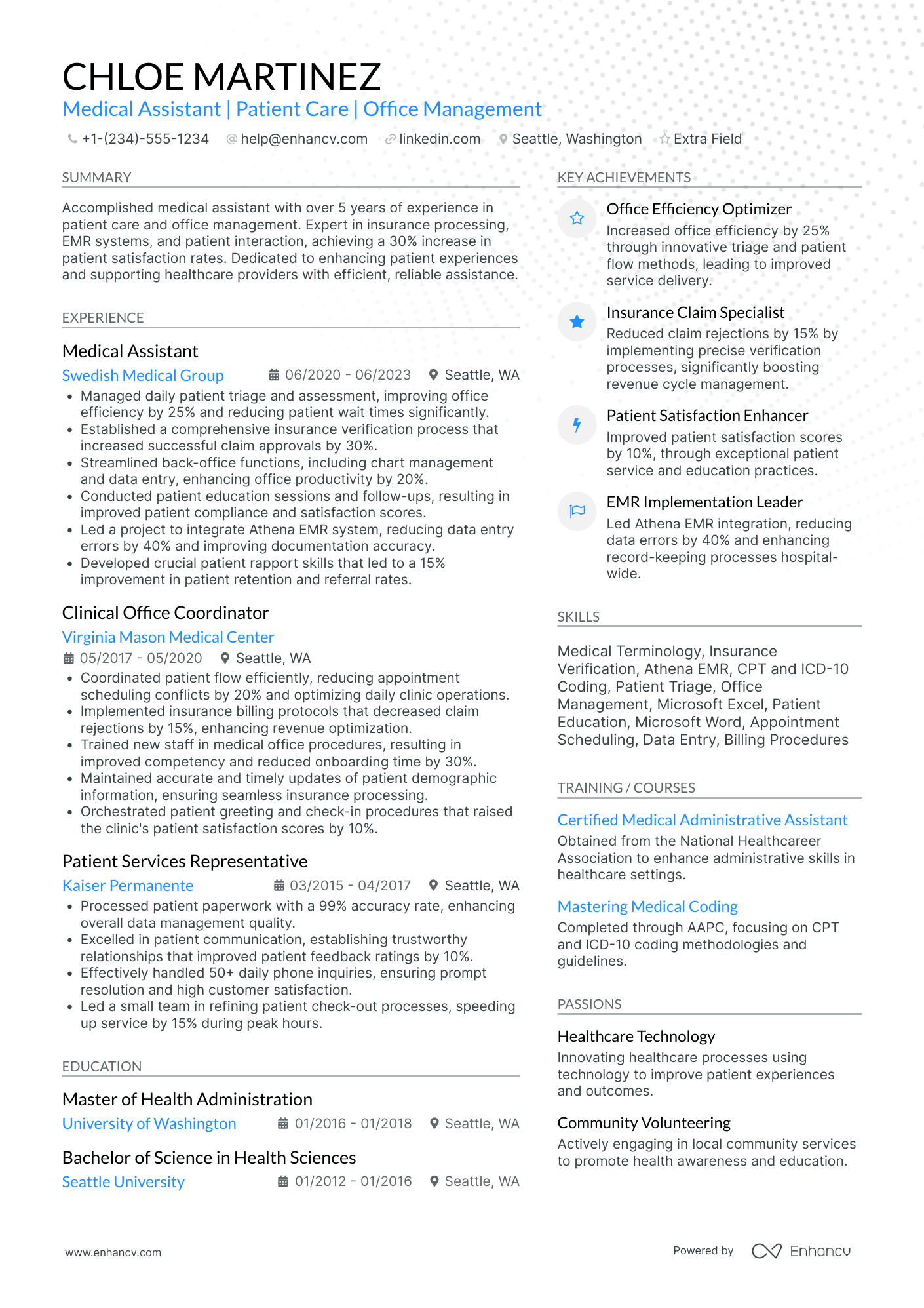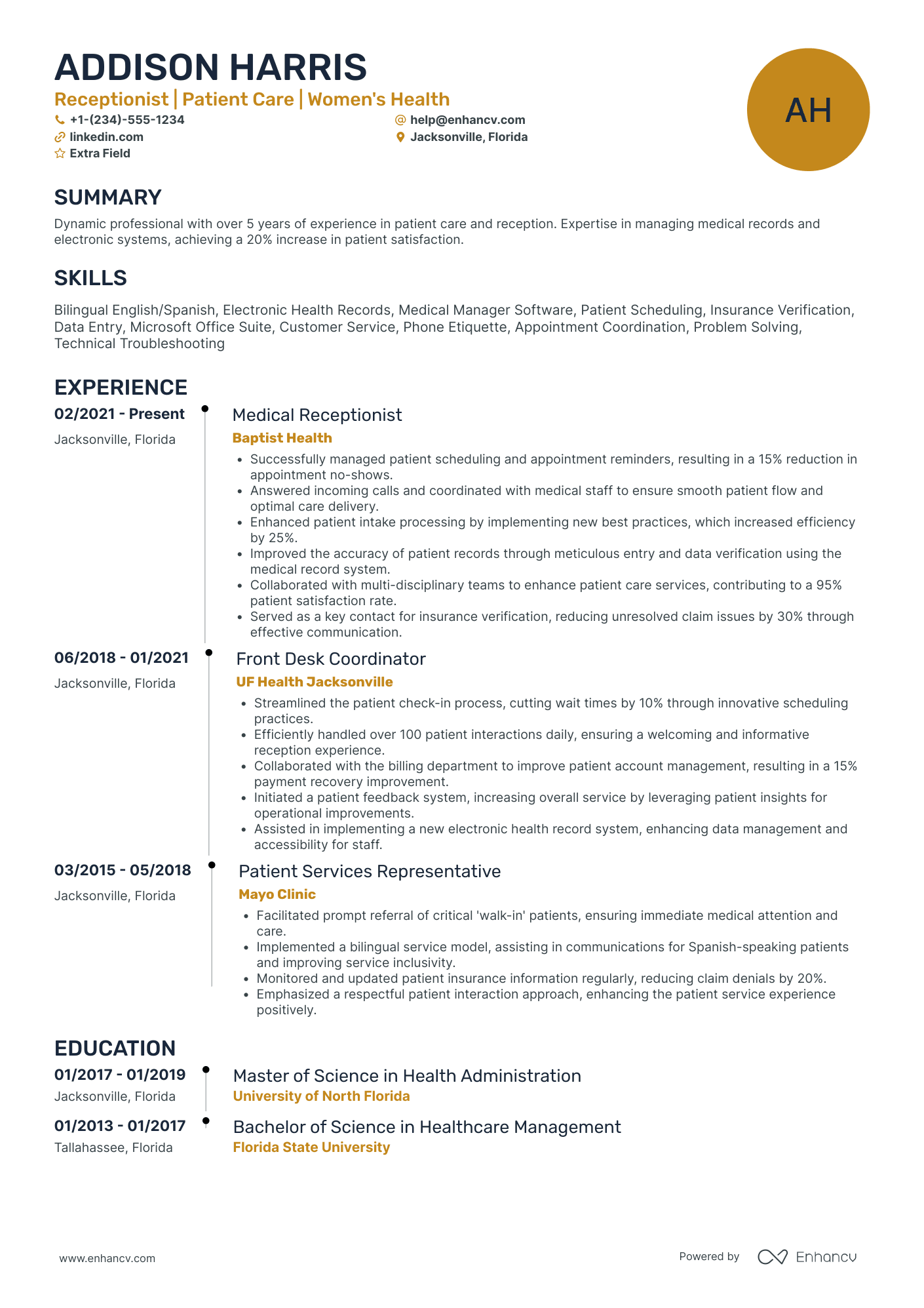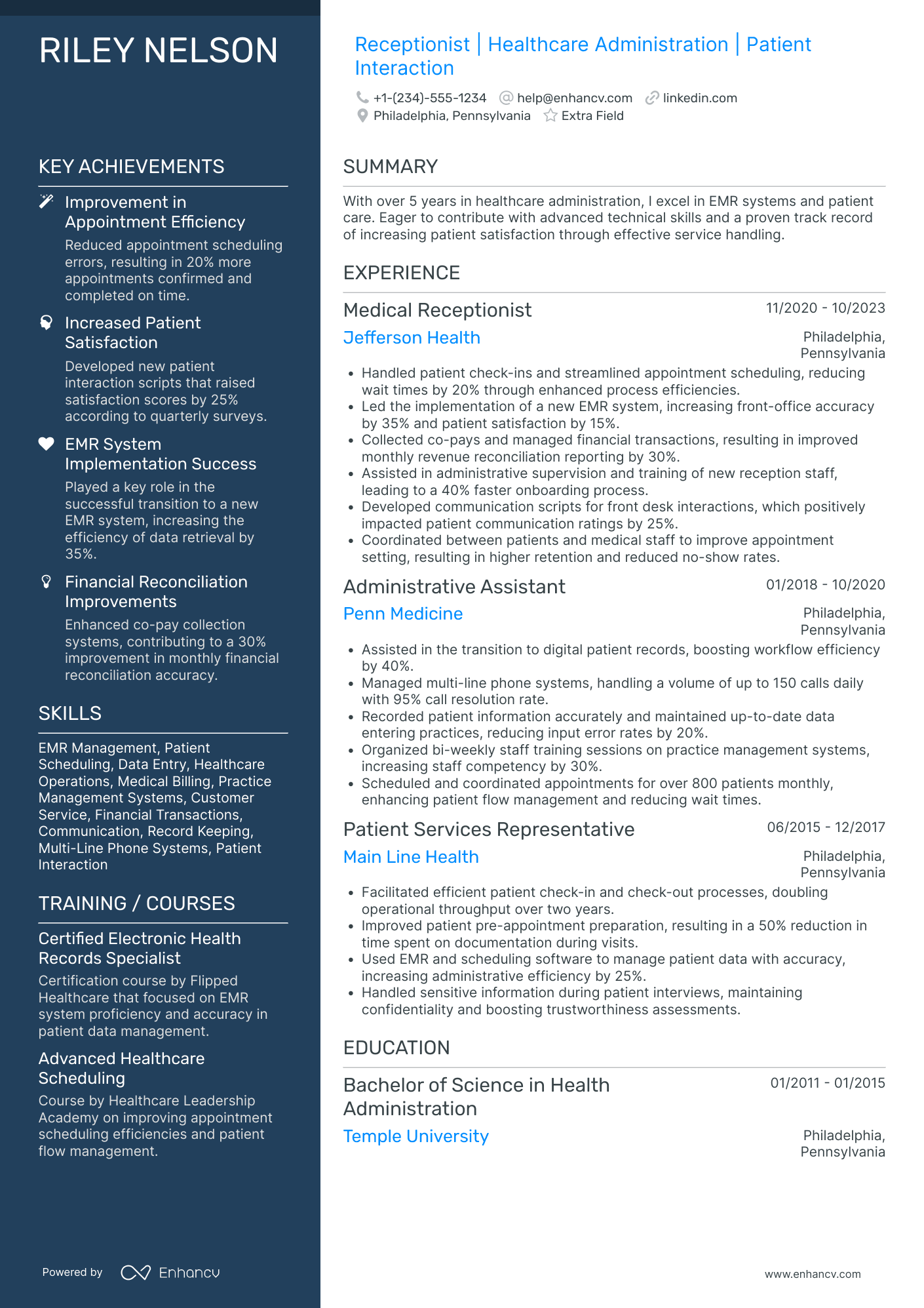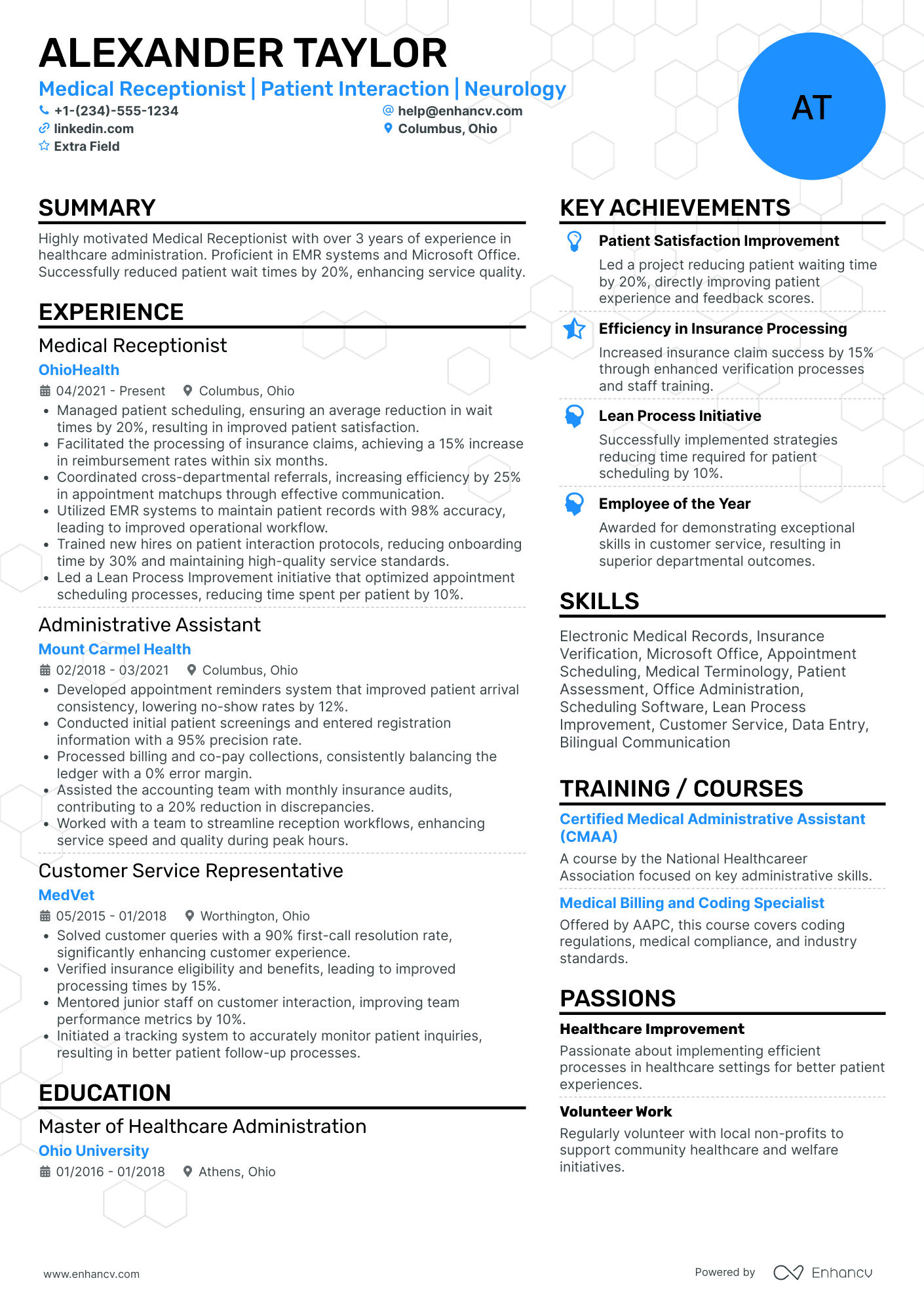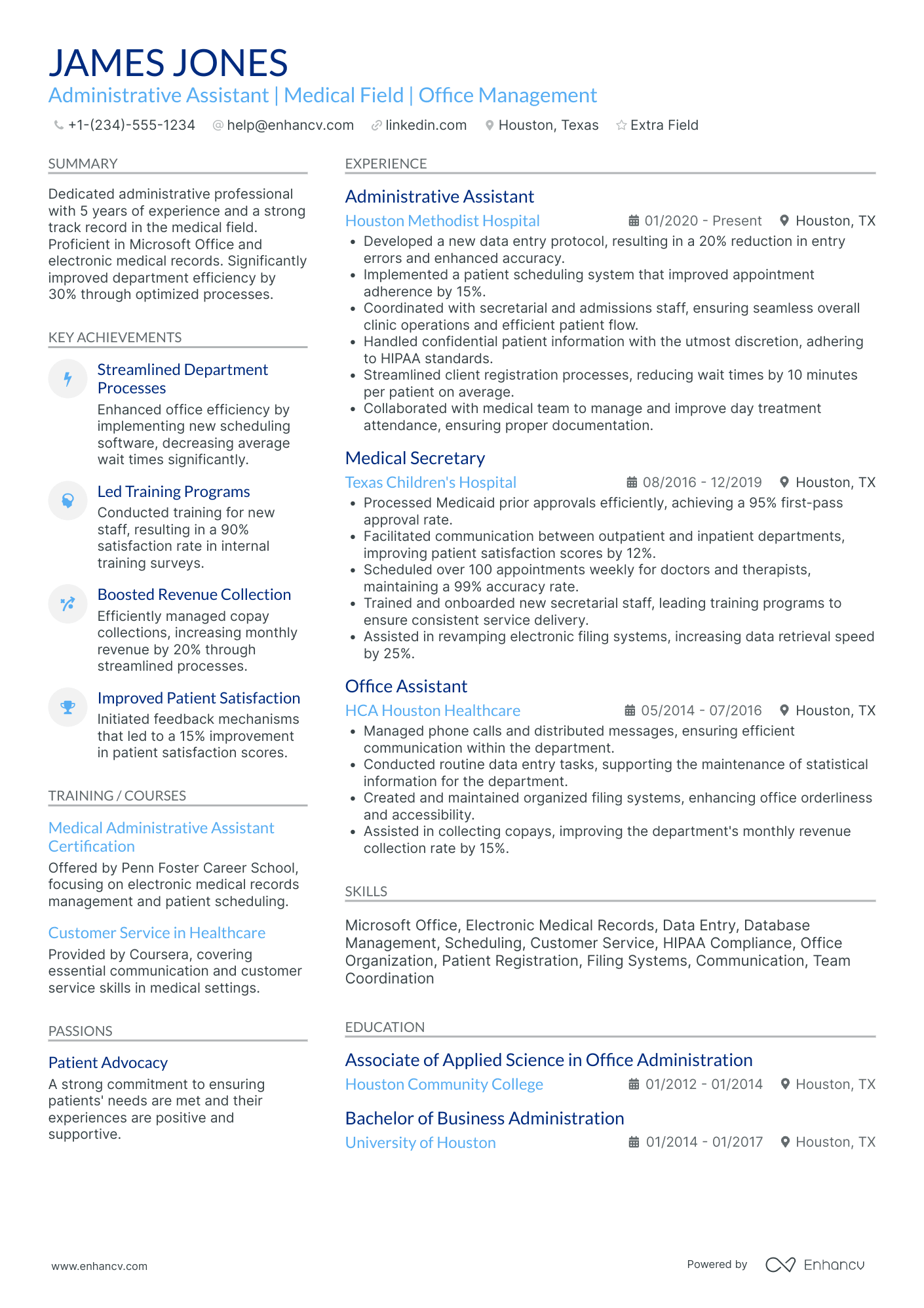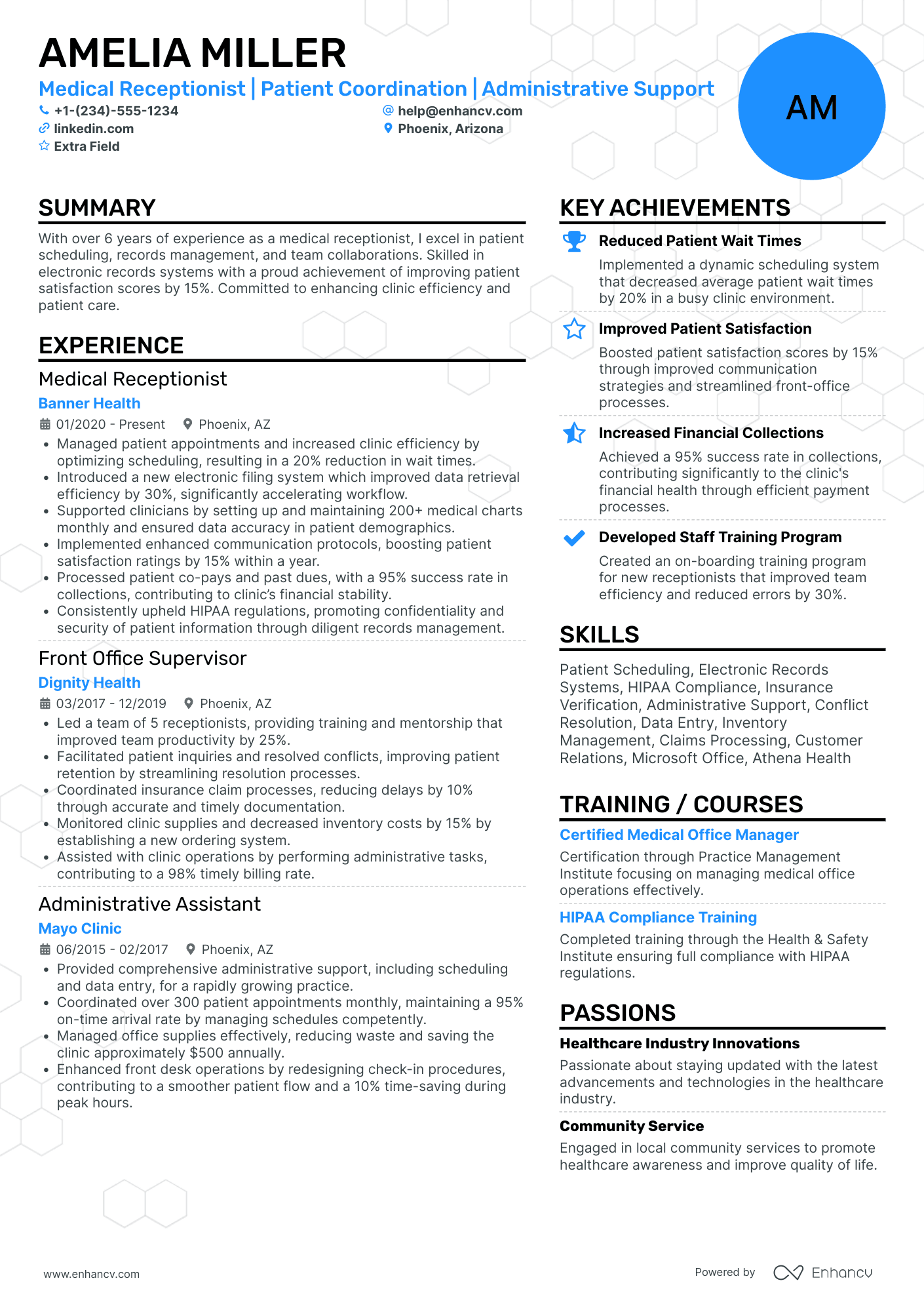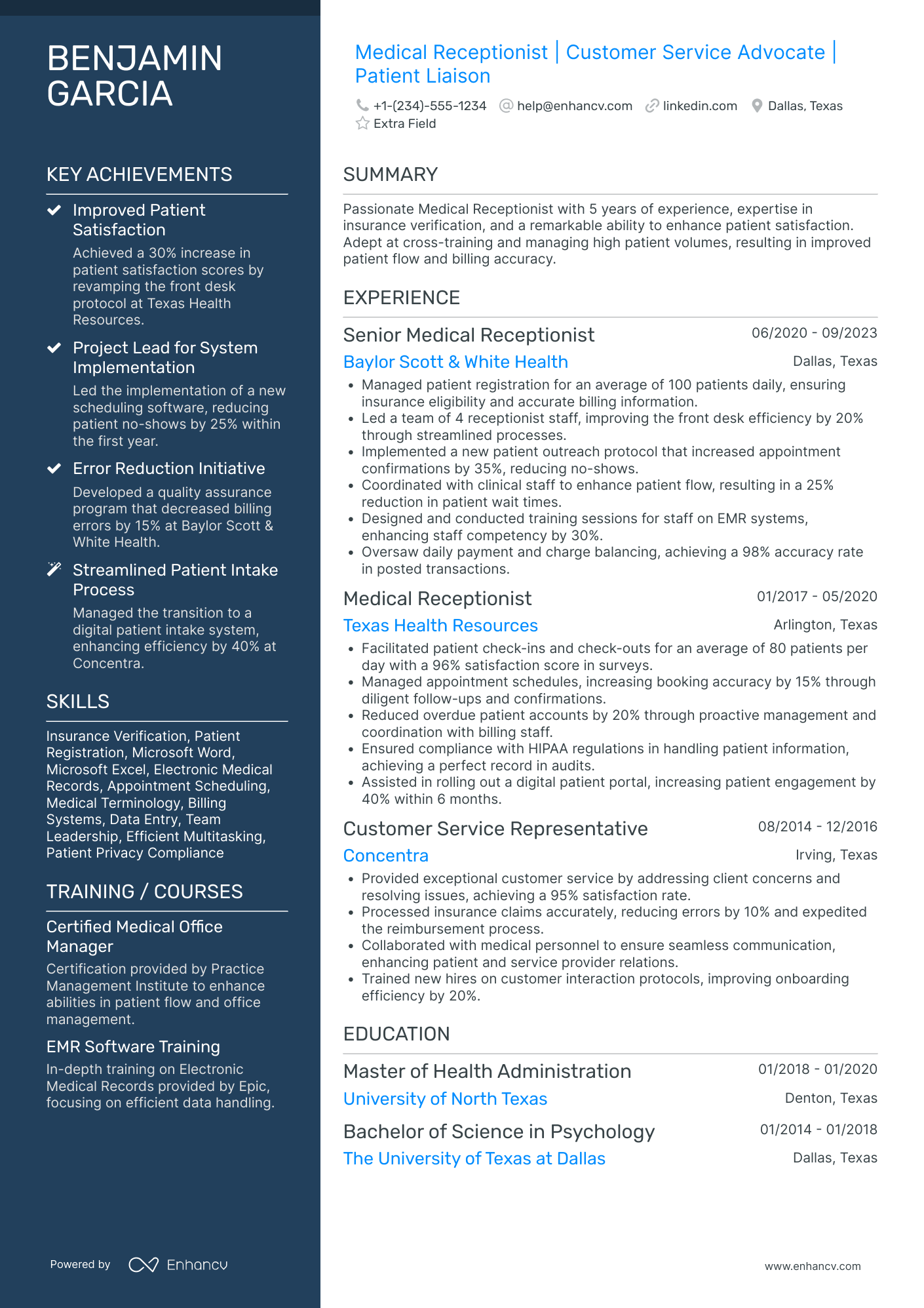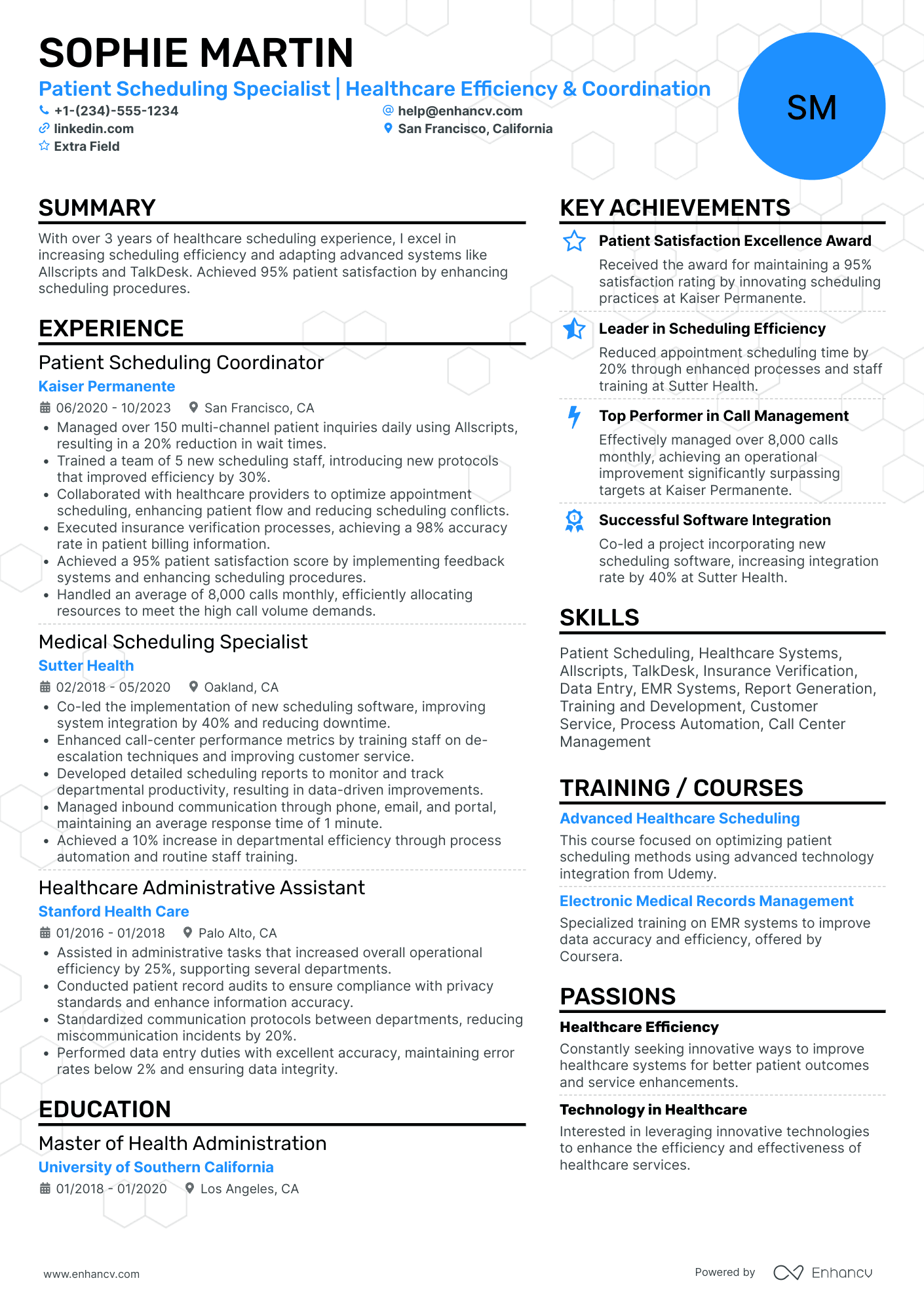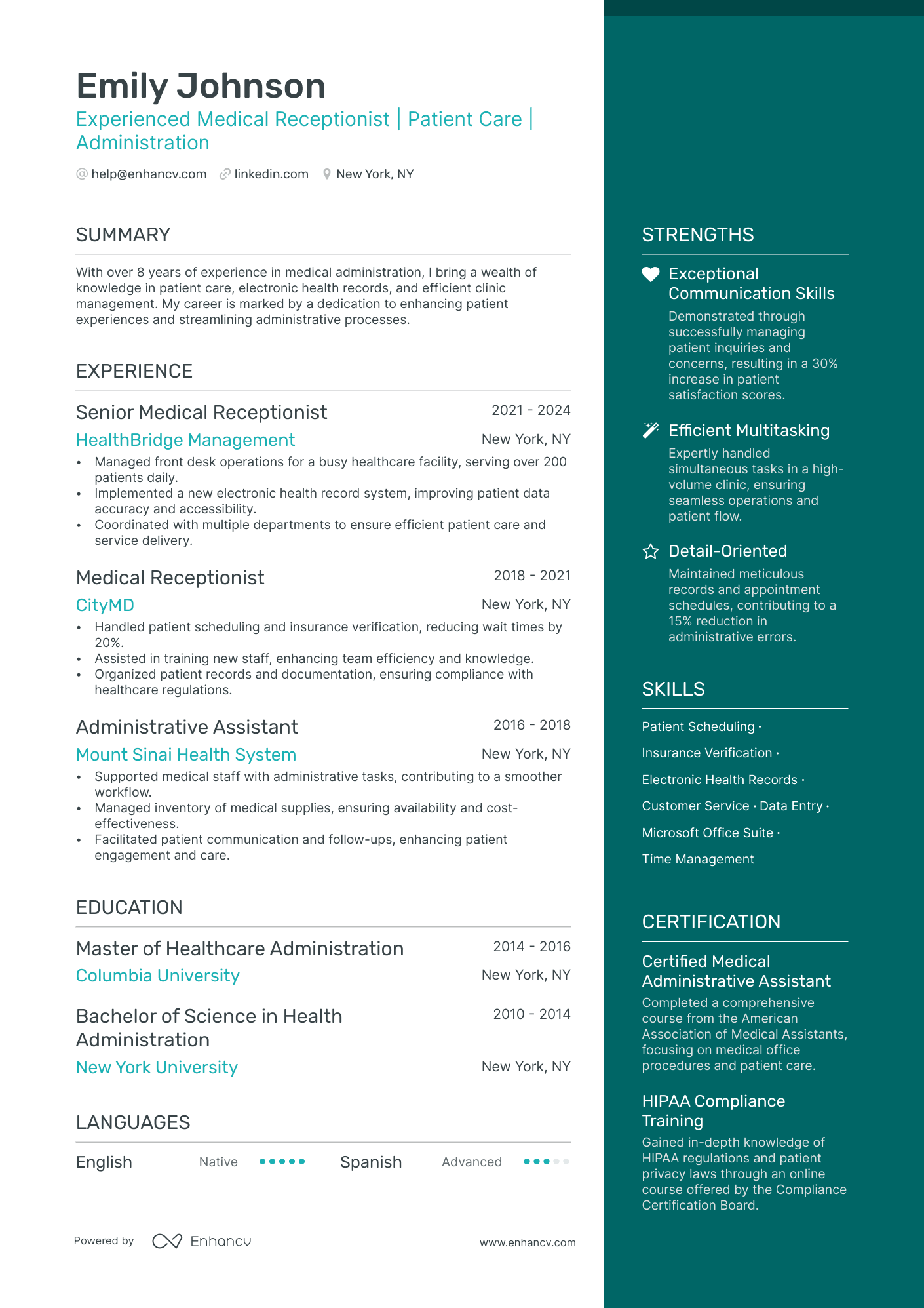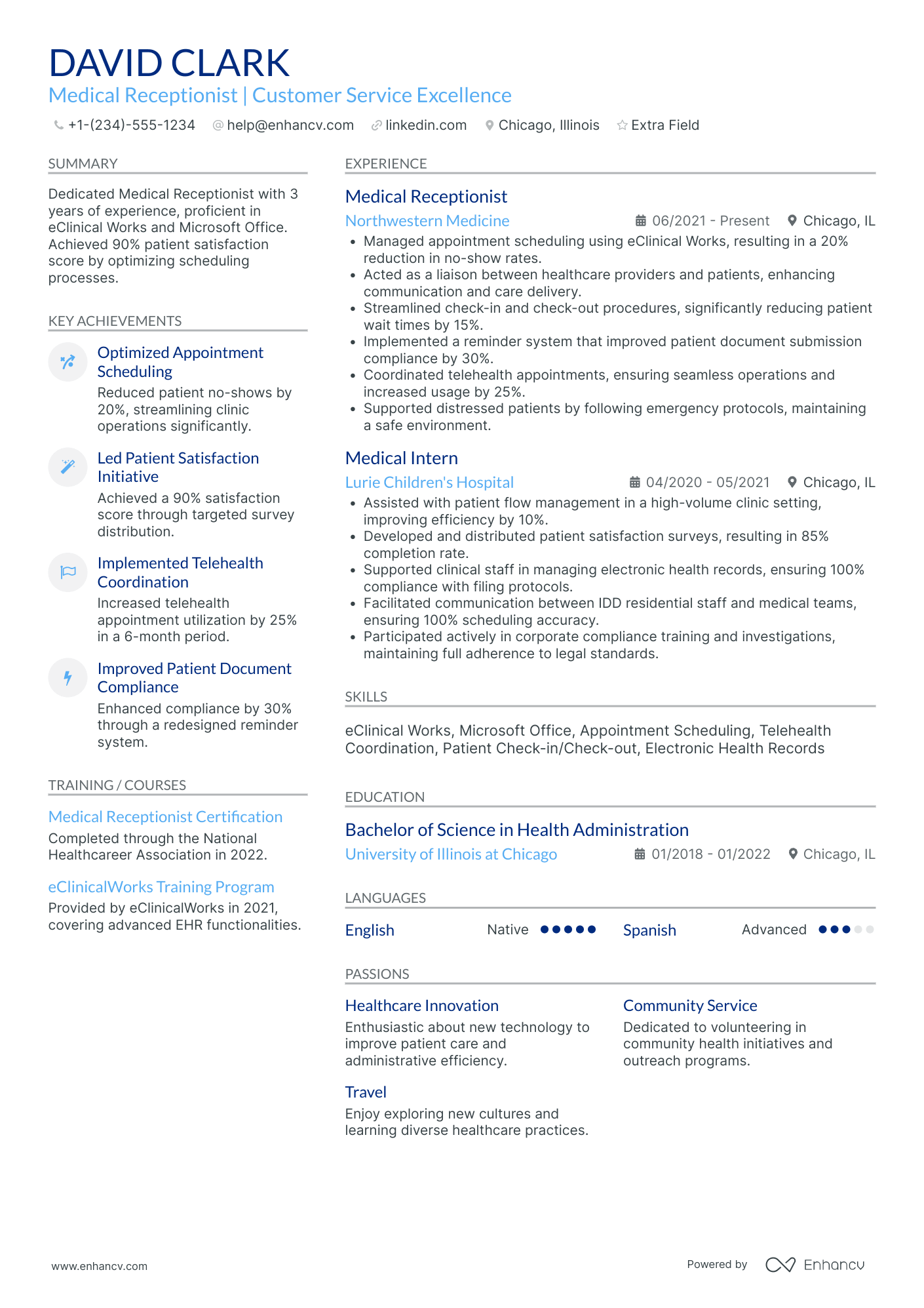Medical receptionists are the book jackets of a medical office. Just as a book cover makes a first impression and provides a bit of insight on what to expect, the receptionist is the first point of contact with a medical office and a positive or negative interaction can have an influential role on whether or not a patient continues to frequent the facility.
Employers look for a friendly, knowledgeable medical receptionist to act as the face of their office. When writing your medical receptionist resume you want to strike a balance between demonstrating technical knowledge and abilities and showcasing soft skills such as a friendly, caring demeanor.
To ensure your resume accomplishes this goal, you’ll need to overcome some of these common medical receptionist resume writing challenges:
- Ensuring your resume stands out to employers using creative, ATS-optimized formatting.
- Highlighting technical skills as well as intrinsic qualities that reflect well on the office.
- Demonstrating transferable skills and quantifiable achievements from past jobs, regardless of your experience level.
- Selecting relevant credentials to create a tailored resume targeted to available employment opportunities.
This guide provides step-by-step instructions and explanations, as well as pro-tips and examples to ensure your medical receptionist resume gets noticed by employers and highlights your most valuable qualifications.
Check out these resume guides for information and examples on related medical careers.
Medical receptionist resume example
Here’s what this applicant does well in their resume:
- Tailored experience: The resume showcases relevant work experience in medical administration, with each role progressively building upon the last. This demonstrates a clear and focused career path that is highly relevant to the medical receptionist position.
- Quantifiable achievements: The bullet points under each job position include quantifiable achievements and specific projects. For example, "reducing wait times by 20%" and "improving patient data accuracy and accessibility" directly relate to the key responsibilities of a medical receptionist.
- Relevant education and certifications: The inclusion of a Master's degree in Healthcare Administration and specific certifications like HIPAA Compliance Training and Certified Medical Administrative Assistant highlights the applicant's commitment to the field and provides an educational foundation that is directly relevant to the role.
- Skills and software proficiency: The skills section is well-aligned with the job requirements, including both soft skills like customer service and technical skills like proficiency using electronic health records and Microsoft Office Suite, which are essential for a medical receptionist.
How to format a medical receptionist resume
A medical receptionist's resume should be well-organized, consistent, and easy to read. Resume formatting is particularly vital for medical receptionists as an opportunity to demonstrate effective communication and technical skills essential in the profession.
Consider the following formatting best practices to ensure your resume's professional and memorable appearance makes an excellent first impression:
- Professional appearance: To maintain a simple, consistent, easy-to-read layout, avoid using excessive creative elements, such as colors, or fancy fonts.
- Header content: A prominent header featuring your name, desired job title, and contact information lets employers view them at a glance.
- Ordering: List all entries in reverse chronological order to ensure your most recent and relevant appear first.
Different markets have specific resume formats – a Canadian resume could vary in layout.
PRO TIP
When searching for available jobs and formatting your resume, it's important to know that while the title "medical receptionist" is still widely used, new titles for the same or similar roles have also been adopted. When formatting your resume header, ensure the job title matches the title used in the job post. These are some of the most common alternative titles for medical receptionist:
- Medical Office Assistant
- Healthcare Administrative Assistant
- Front Desk Coordinator
- Health Services Coordinator
- Patient Coordinator
- Patient Access Representative
- Patient Services Representative
- Front Office Specialist
- Medical Front Desk Specialist
- Admissions Clerk
Applicant Tracking Systems (ATS) are another vital formatting element. ATS software parses resume text, looking for exact keywords or phrases corresponding to desired skills and qualifications. Employers increasingly rely on these systems to prioritize the most qualified candidates for review.
As you format your medical receptionist resume, there are a few best practices you should keep in mind to ensure ATS accurately recognizes text and parses information. These include:
- Fonts: Select ATS-friendly fonts matching the overall style of your resume. Some ATS-friendly fonts are Calibri, Arial, and Times New Roman. However, these commonly used fonts can be dull or generic. For more creative font options, try Rubik, Lato, Montserrat, Raleway, Exo 2, and Volkhov, which are all available on the Enhancv Resume Builder.
- Document type: Doc or PDF files are typical for resumes and most easily analyzed by ATS. We prefer PDFs, as they maintain your formatting across different operation systems.
- Creative elements in text: Avoid using nonessential stylistic features within text. Elements such as emojis and non-standard date formats can impede ATS' ability to recognize information in these sections.
- Headings and subheadings: Ensure resume sections are logically organized and include simple, precise headings. Standard section titles ensure ATS accurately recognizes and extracts information from these sections.
Is your resume good enough?
Drop your resume here or choose a file. PDF & DOCX only. Max 2MB file size.
Section headings enhance resume organization by allowing ATS and employers to recognize your qualifications quickly and easily. Include the following top-recommended sections for medical receptionist resumes to improve the organization of your resume:
The top sections on a medical receptionist resume:
- Contact Information: Is essential so the hiring manager knows how to reach you for an interview.
- Objective Statement: This conveys your career goals, which should align with the medical receptionist position.
- Skills Summary: Highlights your key abilities such as multitasking, communication, and proficiency in medical software, relevant to the role of a medical receptionist.
- Work Experience: Showcases your previous jobs and responsibilities in the field of medical reception, providing credibility and demonstrating relevant experiences.
- Education and Certifications: Informs potential employers about your professional qualifications, including any specific training or certifications that make you a strong medical receptionist candidate.
Medical receptionists have unique backgrounds and qualifications, however, the following are skills and abilities frequently sought by employers and should be explicitly mentioned within the sections of your resume:
What recruiters want to see on your resume:
- Medical Terminologies: Recruiters prioritize familiarity with medical terminologies as an essential element for effective communication with patients, doctors, and insurance companies.
- Organization and Multitasking: Explicitly sharing strong organization and multitasking skills is vital for medical receptionists who frequently manage multiple tasks such as answering phone calls, scheduling appointments, and filing paperwork.
- Proficiency in Office Management Software: Many practices use specific office management software for record-keeping, appointment scheduling, and billing. Therefore, experience with these tools is highly valued.
- Communication: As the first point of contact for patients, outstanding communication skills are crucial for maintaining patient satisfaction and information is conveyed accurately.
- Knowledge of HIPPA: Patient confidentiality is a considerable liability in medical offices. Medical receptionists must understand and respect these laws to handle patient information securely.
How to write your medical receptionist resume experience
Medical facilities can be fast-paced, high-pressure work environments. The best way to demonstrate your capacity to overcome these potential challenges is by sharing successful prior work experiences.
From patient care to technical expertise, the purpose of an experience section is to showcase similar past jobs where you developed and utilized relevant medical receptionist skills.
The most efficient and impactful way to showcase your capabilities is to create a targeted experience section. A targeted experience section is a curated list communicating specific skills and noteworthy achievements that align with the available employment.
PRO TIP
To quickly and easily create a targeted medical receptionist resume for each application, follow these steps:
- Create a resume template including a complete list of your experiences, certifications, education, and skills.
- Make a copy of the template for each new application.
- Review the job description for each new job you apply to, paying close attention to the ideal candidate description.
- In the copy of the template, delete all examples that don't align with the job description.
- Edit remaining examples to ensure they include keywords directly copied from the job description for increased ATS optimization.
A targeted experience section ensures employers recognize relevant experiences at a glance. This is especially important when including appropriate non-medical receptionist experiences to ensure the employer understands the connection and transferable skills.
The example below demonstrates how improving descriptions of a non-receptionist role clarifies its relevance:
- •Utilized computerized systems for reservations, check-ins, and tracking guest preferences.
- •Managed phone inquiries, providing information about room availability, rates, and hotel amenities.
- •Coordinated with housekeeping and maintenance staff to address guest requests and maintain a high standard of cleanliness and functionality.
- •Efficiently handled check-in and check-out procedures, maintaining accuracy in guest information and payment processing.
While some of the skills may be related or transferable to a medical receptionist role, the connections are not apparent from these descriptions. For example, computer software systems used in hospitality are presumably quite different from those used in medical offices. This means transferable skills developed using hospitality software would be negligible. Additionally, managing many phone calls to provide information and answer questions is a transferable skill. However, including hotel industry-related specifics would not be impactful for employers seeking a medical receptionist. Replacing these irrelevant details with quantitative data, such as numbers or statistics, would be a more impactful way to present these skills.
- •Implemented organizational strategies, reducing check-in time by 20% and contributing to a 25% improvement in overall guest satisfaction.
- •Achieved a 95% guest satisfaction rate by promptly addressing and resolving an average of 20 guest inquiries daily.
- •Demonstrated exceptional multitasking ability by effectively managing an average of 15 simultaneous tasks, resulting in a 15% improvement in overall front desk efficiency.
- •Managed daily cash transactions averaging $5,000 with 100% accuracy, reconciling accounts promptly and minimizing discrepancies.
This experience description is significantly improved by making two modifications. First, the applicant tailors the items to present highly transferable skills for medical receptionists. These include organization, customer service, guest/patient satisfaction, multitasking, efficiency, accuracy, and fiscal account management. The second improvement is including numbers and data to quantify achievements. For example, the “25% improvement in guest satisfaction” resulting from their efforts would undoubtedly appeal to a hiring manager looking for a similar improvement in patient satisfaction.
How to quantify impact on your resume
An easy and effective way to boost your resume's impact is to use quantifiable data in your experience descriptions. Quantifiable evidence is tangible, measurable, or verifiable details, aka numbers, that highlight your accomplishments in past jobs.
For example, stating you have experience working in a “fast-paced medical environment” is less effective than saying you were the “sole receptionist in an office of four doctors, seeing an average of 50 patients daily.”
Here are a few excellent options for incorporating numbers and statistics to enhance your experience descriptions:
- The number of patients you handled daily at your past job shows your ability to manage a high-volume workload.
- An average number of calls taken daily demonstrates excellent communication and multitasking skills.
- How many medical professionals you interacted with regularly illustrates your capabilities working with a diverse team.
- The number of medical or office management software you are proficient in proves your technical acumen.
- Percentages indicating improvement in patient satisfaction scores under your reception management share your commitment to quality service.
- The number of insurance claims you input monthly evidences your understanding of billing practices.
- Decreases in missed appointments or wait times as a result of your endeavor speak to your scheduling efficiency and evidence your direct positive impact on the practice.
- A percentage reduction in filing or administrative errors during your tenure, emphasizing your organizational skills and accuracy.
Be mindful when including quantitative data in your resume. All data must be accurate, factual, and tailored to evidence your top skills. Overusing numbers and statistics risks losing both the impact of the data and the reader's attention.
How do I write a medical receptionist resume with no experience
Even if you’ve never worked in a medical office, chances are you’ve visited one. If you’ve ever had difficulty getting an appointment quickly or having a question answered, you know how frustrating these experiences can be.
Drawing on your own experiences, good and bad, will help you understand the transferable skills and personal qualities you can present on your resume by including non-medical receptionist work experiences.
Another excellent source of inspiration is the job description, which contains keyword skills employers and ATS will look for on your resume.
PRO TIP
Providing high-quality patient care requires many of the same skills as delivering excellent customer service. For example, patience, empathy, active listening, and problem-solving skills are beneficial in both professions. A background in customer service, even in an unrelated field, is an excellent experience example to demonstrate those skills on your medical receptionist resume.
Follow these steps to write your experience section without prior experience:
- Compile a list of keywords from the job description.
- Brainstorm previous employment, educational, or volunteer experiences showcasing the same keyword skills and knowledge from your list.
- Add credibility by including tangible evidence of transferable skills, such as certifications and quantifiable data.
- Avoid including irrelevant work experiences or outdated experiences.
- List experiences in reverse chronological order to ensure your most recent and relevant examples appear first.
How to list your hard skills and soft skills on your resume
People don't care how much you know until they know how much you care
Theodore Roosevelt
The above quote aptly describes how employers value medical receptionist skills. Being an outstanding medical receptionist requires various hard skills, demonstrating competencies and soft skills, reflecting your demeanor and work ethic. However, soft skills that have the potential to reflect positively on the facility and augment patient satisfaction will be coveted by employers.
The skills section of your medical receptionist resume should include subsections for hard and soft skills, enabling employers to consider your top qualifications quickly and easily.
Hard skills are the skills necessary to perform a particular job. They typically require study, training, and practice. In the medical field, they often require certification.
As a medical receptionist, these skills usually relate to technical abilities using office management software, software systems such as electronic health records (EHRs) like EPIC or CERNER, medical billing software, and scheduling tools.
Here are some of the top hard skills sought by employers looking to hire medical receptionists:
Best hard skills for your medical receptionist resume
- Knowledge of Medical Terminologies
- Patient Record Management
- Multiline Telephone System Operation
- Data Entry Skills
- Medical Billing
- Electronic Healthcare Records (EHR) Software Proficiency
- Medical Coding
- Appointment Scheduling Software Proficiency
- Insurance Verification
- Health Information Systems (HIS)
- Database Management
- HIPAA Compliance
- Proficiency in Microsoft Office Suite
- Email Management
- Medical Transcription
- English Proficiency
- Reception Desk Operation
- IT Troubleshooting
- First Aid Certification
- Understanding of ICD-10 Codes
Soft skills are skills related to your personality and work style. These skills are transferable from one position to another. For example, skills such as multitasking and maintaining calm in stressful situations are critical for medical receptionists who often simultaneously check in patients, answer phone calls, and schedule appointments.
Generally, employers may be willing to train employees in hard skills. However, their intrinsic nature makes soft skills more challenging to teach. Therefore, your resume must include a thorough, targeted list of your most valuable soft skills.
These are the top soft skills employers look for on medical receptionist resumes:
Best soft skills for your medical receptionist resume
- Excellent Communication
- Customer Service Orientation
- Creating Good Rapport
- Conflict Resolution
- Attention to Detail
- Time Management
- Empathy
- Adaptability
- Multitasking
- Problem-solving
- Discretion and Confidentiality
- Stress Management
- Teamwork
- Positive Attitude
- Decision-making
- Interpersonal Skills
- Patience
- Professionalism
- Promptness
- Active Listening
- Organizational Skills
Like your experience section, creating a targeted skills section listing skills well-aligned to the job description is most effective. This allows employers to quickly and easily notice skills demonstrating your potential to succeed.
Follow these steps to write your medical receptionist skills section:
- Format your skills section as a simple list without elaboration or examples.
- Differentiate between hard and soft skills by listing them in separate subsections.
- Target your list for individual positions using keyword skills from the job description.
- Write skills precisely as they appear in the job description to enhance ATS optimization.
- Never lie or exaggerate your skills.
- Check for consistency between your experience and skills sections. List the skills mentioned in the experience section in the skills section, and vice versa.
How to list your certifications and education on your resume
Your resume's education and certifications sections provide evidence of the hard skills and foundational knowledge you will bring to the position.
In most cases, a high school diploma or equivalent is the minimum educational requirement for a medical receptionist. However, some employers prefer candidates with additional education or certifications, such as an associate degree or vocational training in medical office administration, healthcare administration, or a related field.
Follow these steps to write your education and certification sections:
- Create separate sections titled "Education" and "Certifications" to allow ATS to parse information from your resume accurately.
- List all degrees and certifications in reverse chronological order, putting your most recent and relevant at the top.
For education and degrees, follow these steps:
- Include the name of the university, its' location, the dates you attended, and the title of your degree.
- It is optional to state a GPA unless the job description specifies a minimum GPA requirement.
- Major and minor should only be mentioned when relevant.
Here's an example of how an education item should look on your medical receptionist resume:
Follow these steps when listing certifications on your resume:
- Include the name of the certification, the certifying institution, and the year obtained.
- Limit certifications to current, unexpired credentials.
- If a certification requires renewal to remain valid, include the date first acquired as well as the most recent renewal date or a "valid through" date.
- Limit certifications to only those specifically named or directly related to the required skills mentioned in the job description.
Certifications are an excellent way to set yourself apart from other candidates. If you're considering adding a medical receptionist certification to your resume, you can find the most highly sought-after by employers here:
Best certifications for your medical receptionist resume
How to write your medical receptionist resume summary or objective
A summary or objective, sometimes called "Resume Profiles" or "Personal Statements," is an excellent way to briefly give context to the information on your resume.
A good summary gives an employer some insight into who you are as an employee in addition to your career progression and goals. They also allow you to highlight specific skills and achievements that are well-aligned for a particular job.
The difference between a summary and an objective is the focus on either your past experiences or future career goals.
A summary draws upon comparable work experience to outline your most relevant qualifications. Alternatively, an objective focuses on the future, describing how your career goals align with the available job.
A summary is preferable for medical receptionists with extensive experience since it draws on comparable prior work experiences to outline your most relevant qualifications. For example, a summary is well suited for an applicant who has worked for the last five years in a pediatric office and is applying for a job in another pediatric office. A summary aims to highlight your past success as an indication of potential future success.
To write a medical receptionist resume summary, follow these best practices:
- Highlight your most relevant skills or experiences that directly overlap with the job description.
- Write an impactful description using keywords directly from the job description.
- Be brief. A summary should only be 3-5 sentences.
PRO TIP
Rephrasing specifics from the “Qualifications” or “Ideal Candidate” sections of a job description is a great way to guarantee you mention the skills and qualifications most valued by the employer.
Alternatively, an objectives section is a better option for candidates with limited or no experience as a medical receptionist. An objective allows you to look toward the future, focusing on how you plan to use non-receptionist experiences, background knowledge, and transferrable skills to contribute to the success of the office and achieve career goals.
To write your medical receptionist resume objective, follow these best practices:
- Describe the type of position you are seeking.
- Share relevant or transferable hard and soft skills that will help you succeed in the position.
- Highlight your motivation to learn and gain experience while making valuable contributions.
- Use keywords directly from the job description.
- Be brief. Keep your objective to 3-5 sentences.
A common mistake made when writing resume objectives is being too general. Failure to include specifics usually means missed opportunities to integrate keywords tailored to a particular job and results in a bland objective that fails to grab the attention of employers.
Check out how the following objective is improved by giving details and implementing keywords from the job description.
This objective is very generic. It fails to include specific skills or communication abilities. It doesn’t explain how the applicant formed their knowledge of healthcare administration nor how they will contribute to the success of the unnamed organization. A generic summary makes a generic impression on employers who would not likely believe this applicant was excited about their job and has little information to form a memorable opinion of the applicant.
This improved objective incorporates keyword skills and specific details such as the applicant's degree in medical office administration, passion for patient care, and desire to grow their hands-on experience in a pediatric care setting. These details form a much clearer picture of who they are, the background knowledge and skills they expect to contribute, and the goals they hope to achieve. The result is an objective statement that is far more likely to stand out and make an impression on employers.
Optimize your resume summary and objective for ATS
Drop your resume here or choose a file.
PDF & DOCX only. Max 2MB file size.
Additional sections for a medical receptionist resume
Once you've included your top-resume sections, consider adding one or more of these optional resume sections to highlight specific qualifications or accomplishments and ensure your resume stands out.
- Languages: Excellent patient communication is a cornerstone of the medical field, and medical offices serve diverse patient populations. Therefore, speaking multiple languages is a valuable asset in patient-centric medical environments. Including a language section is an effective way to give yourself a leg up on the competition.
- Achievements and Awards: If you've received recognition for your work in the past, consider including an awards and achievements section as evidence to support your stated soft skills. For example, an award for excellent patient care or for being a top employee demonstrates a commitment to excellence in your work. In addition to individual awards, you can include awards your office or team received, such as being voted top healthcare facility in your community.
- Volunteer Experience: Volunteer experiences are an excellent addition to medical receptionist resumes, especially for those with limited work experience in the medical field. For example, if you are applying for a position in a pediatric office, sharing an experience volunteering for a youth organization is a great way to demonstrate your experience working with children.
- Professional Associations: A professional Associations section highlights your dedication to ongoing improvement and staying current in the medical field. If you would like to include a professional association membership to your resume, consider joining one of the leading professional associations for medical receptionist listed below.
Professional associations for medical receptionists
Individualizing your resume with tailored sections will ensure it reflects all your top qualifications and stands out among other applicants. Should you include sections other than those above, be sure they use catchy, ATS-friendly headings.
How to add a specialization section to your medical receptionist resume
Working in specialized medical facilities often requires specialized skills and knowledge, such as knowledge of medical insurance and coverage, appointment types, or working with a particular patient demographic. If you have extensive experience or certification in a particular medical specialty corresponding to an available position, showcasing this experience in a specialization section will highlight these qualifications.
Your specialization section should include the following:
- The title of your medical specialization
- Years of experience in the specialty
- Specialty-specific training or certifications
- Specialty-specific medical billing and coding experience
- Technical skills using particular office management software.
- Relevant soft skills, for instance, compassionate patient education and care in an oncology office.
Here is an example of how your specialization section should appear on your resume:
While a specialization section is an effective way to evidence experience, knowledge, and skills, it should only be included as a unique section when applying to a medical receptionist role in the same specialty. For example, the specialization section above would be relevant when applying to a psychiatric office or mental health facility position. Otherwise, these skills may be mentioned in the other resume sections, such as the experience section, to demonstrate your capacity to learn specialized skills.
Key takeaways
The best medical receptionist resumes don’t simply showcase technical skills and certifications. They share personal qualities that will reflect well on the office and enhance patient satisfaction. Remember these key elements to ensure your resume highlights all the skills and qualifications that make you an exceptional medical receptionist:
- Resume formatting helps ensure your resume stands out to employers and ranks highly in ATS analyses of qualifications.
- Targeting your experience descriptions highlights your most valuable skills and achievements for a medical receptionist job.
- Soft skills highlight your ability to treat patients with kindness and compassion, which enhances their satisfaction and experience.
- Certifications and achievements effectively demonstrate foundational knowledge and help your resume stand out among numerous applicants.
- Include details in your objective statement to ensure it stands out to employers.
- A specialization section is an excellent tool to highlight medical receptionist jobs in the same specialty as the available job to highlight your expertise.
Medical Receptionist resume examples
By Experience
By Role
